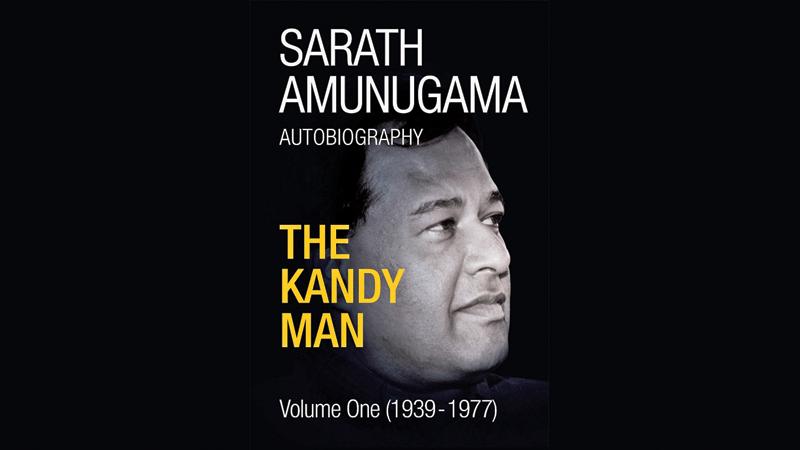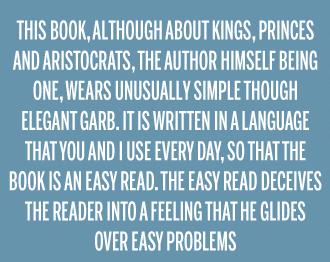
The candy man in The Kandy Man, Volume One, one of three designed to constitute the autobiography of Sarath Amunugama, scholar, distinguished public servant, aesthete, politician and a minister. As expected, he brings us not only double boiled sweets that his ‘beloved nanny Roslin bought for him on the way home from Girls’ High School, Kandy, but also whole truckloads of current history, enormously helpful insights into the working of institutions with which he was associated and the roles he played often on the main stage and sometimes on the sidelines, both literally and metaphorically. In this review, I shall highlight the nature of institutions with which he was associated.
Those who wish to trace his meteoric rise from Cadet in the Civil Service to Permanent Secretary at the age of 38 can do so with enjoyment in the volume under review. I strongly recommend it because there is much to learn and instructions to follow.
Not only did Amunugama make history himself, but was a witness to history in the making for most of the life of this young Republic and his long eventful life.
Many in similar vantage points have tried to write to the same effect but few have succeeded in abstracting their experience into the context of the society they lived in, so, that in writing their biography they were also writing contemporary history, which purists might argue is a contradiction in terms.
To annul their contention, one only has to read good history which has fed sumptuously on autobiographies and study the art of writing biography that Lytton Strachey introduced when he wrote Queen Victoria. Roy Jenkins is an admirable successor, but I am running ahead of myself. Let us hurry slowly- festina lente.
The first institution that Amunugama introduced to us was his family. The Amunugama clan had had an illustrious history and some males were executed for their participation in the Rebellion of Matale in 1818. Family properties were confiscated and families thrown into poverty.
Poverty may have been one of the reasons why the Amunugama family had been strongly represented in the monkhood of the Malwatte faction of the Siyam Nikaya. Young men of the clan were much sought after for binna marriages and the families gradually re- built themselves.
The Amunugama family
 Sarath’s father was brought up by a relative in Panadura and he attended St. John’s College there, which brought a new tinge to the life of his children. His father was unusually keen that his children should gain from education and Trinity College in Kandy was his choice for young Sarath.
Sarath’s father was brought up by a relative in Panadura and he attended St. John’s College there, which brought a new tinge to the life of his children. His father was unusually keen that his children should gain from education and Trinity College in Kandy was his choice for young Sarath.
His father took a great interest and derived much pleasure from the growth and development of his son. The account of the family is full of insights into the organisation of the Kandyan radala society and would be helpful to scholars studying that aspect of life in Kandy in the late 19th century and the first half of the 20th century .
The second institution we are introduced to is Trinity College, Kandy. Trinity together with S.Thomas’ College, Mount Lavinia and Richmond College, Galle had been, established on the model of English Public Schools. In England they date back to a distant past and have strong traditions.
The system of ‘courts’ in Public College Schools were carried onto colleges in Oxford and Cambridge and Whewell Court in Trinity, the second court in St John’s and the Front Court in St.Catharine’s are much admired. Trinity College had only two: one for the Upper School and the other for Middle School. Sarath took part in every activity in school, cadetting, games and the lot.
He was also a Prefect of the school. Again, the role of Prefects in public schools in England is very special. They almost ran the school, except for teaching. The Headmaster had great trust in them. This was a major part of training these young men in leadership.
University of Peradeniya
Sarath was really preparing to go to university. We meet him in Peradeniya in 1957. Together with the University Park so lovingly cared for by Shirley d’Alwis and his workers, and ‘the small, good university’ nurtured by Jennings, the Kandy Man blossomed brightly and fragrantly. The young man was on his own and was soon elected President of the Students’ Union, a position that foretold leadership in adult life.
He plunged into all activities at the university. He even wasted time in those classes on Marxism, taught outside the University by dons who took to Trotskyism. There were two passions he yielded to without reserve: the new discipline of sociology and the newly vibrant creative activities of mostly young teachers in the Sinhala field and related activities. In his autobiography, his admiration of Siri Gunasighe, a Samskritic who later turned art historian, is almost sky high. Gunasinghe was the idol of smart young undergraduates: highly intelligent, friendly, creative and at points iconoclastic.
He was more adventurous than Sarachchandra in innovation: costumes for plays, free verse and novels on subjects hitherto untouched by the literati. Young scholars followed him with enthusiasm, among them Gunadasa Amarasekera (an undergraduate in the Dental School), Wimal Dissanayake ( who from a poet grew to a film critic of international fame) and Amunugama himself who breathed the fine air that Gunasinghe caused to blow over the undergraduate population. Gunasinghe cultivated the best traditions of university teachers for which Jennings had designed Peradeniya and students were in and out of his home.
At university, one learnt not only in lecture theatres and libraries but also from incessant jabber with fellow students and informal and casual conversations with teachers. The other major figure, the one who loomed large in the public eye was Sarachchandra.
He was short, simple and casual in appearance but deadly serious in his intention to invent a tradition of the theatre that would appeal to both the literati and the woman in the marketplace.
He was successful even beyond his expectations when he presented a series of plays that began with Maname. (My own reactions to the first staging of the play I wrote up in the novel Alut Matanga.) Sarachchandra exploited the fondness for Jataka Stories that was in the minds of the average Sinhalese and used them as plots for his plays.
One favourite story was that of the bodhisatva who was named Kachchaputa, an honest trader of fancy bangles and Sarachchandra staged it as Kada valalu and Amunugama was cast as Kachchaputa. Many of the actors and singers in Sarachchandra plays had been from schools other than from Colombo but Amunugama played the part to perfection.
He breached the large gap even without a leap. Sarath’s other passion was sociology. A department for the study of sociology was set up with the hard work of Ralph Peiris who had studied the discipline at a London University. He had two brilliant, young and enthusiastic teachers in S.J.Tambiah and Gananath Obeysekere, both of who rose to world leadership for their work in anthropology. There were others including D.L.Jaysuriya.
Peiris sought the help of the Departments of Economics, History and Sinhala to fill the gaps in teaching. The students who chose to study Sociology had a commitment to the discipline and they had young and ambitious teachers committed to teaching. The results were inevitable. Several outstanding students emerged, Amunugama first among them. Scholarship never left him and there has been a constant output of high quality work.
Tissa Balasuriya wrote a brilliant study of the life and work of Sarananakara. H.L.Seneviratne was Prof of Anthropology at the University of Virginia teaching and researching with substantial publications to his credit. Namel Weeramuni became a creative artist and directed a new play that was popular.
Both Tambiyah and Obeyesekere took to the new techniques of field studies to formulate hypotheses and test them. I together with some others took part in the Patha Dumbra Survey, the results of which were partly published in The Disintegrating Village. The full report of the Survey could not be published. But The Disintegrating Village had its effect on the discipline as Amunugama records in this volume. Sarath collaborated closely with Obeysekere in the latter’s field work that went into the Pattini Cult, which brought much credit to Obeysekere. In an assessment of scholarship in social anthropology in South Asia, P.T. Madan said, “the work of two distinguished Sri Lankan anthropologists Gananath Obeysekere and Stanley Tambiah….. Sarath Amunugama was part of all this.
The Ceylon Civil Service
Sarath had an enormously successful university life and walked into the Ceylon Civil Service. Thus, began the introduction to the fourth institution which comes in Volume One. He liked provincial administration very much, which was mostly land administration. He travelled to villages, talked to villagers, solved problems that could be solved on the spot and took down notes for continuation of studies in the university. The outcome was a collection of essays published a few years back.
After serving in Ratnapura and Galle, Sarath moved as AGA to Kandy, partly to be near his father who had fallen ill and had received excellent medical attention, partly on the intervention of the son. Ever the keen student, Sarath cultivated his interest in local artistes including dancers and drummers. Back in Colombo at the Ministry of Finance together with another brilliant Civil Servant he produced the Establishments Code, that to date guides public servants.
Later, he became the head of a department as Director of Information which brought him in touch with artists including singers. This was an opportunity to exercise his creative talents and he did so to the fullest. The Government Film Unit found a new and better home. He travelled widely. I am running short of words and must stop, as Wittgenstein might have said. As you can see there is much to talk about, to think about and argue about in this volume and what would you do except read it.
There are numerous niggles that must be removed in a future print. Besides, there is an annoying confusion about Polgasduva, in the shadow of which I grew up. It is not an island on Madu Ganga that flows to the sea at Ahungalle but is on the small Ratgama Lagoon, connected to the sea at Morakola.
The lagoon fills up a sudden depression in the land as it slopes down East West to the Indian Ocean, into which drain the runoff from the villages of Ratgama, Karudampe, Pinkande, Sudumetiya, Beratuduva, Hennatota and Patuvata. Polgasduva was the hard rock with thin topsoil that did not drop down with the rest of the basin.
Consequently, there are only a few stunted coconut plants and brush land in which grows occasionally, a himbutu, bovitiya or dan plant. The isolation of the small island made it ideal for bhikkhus who wished to live quietly to develop their minds, as most samana had done several centuries back. It is far removed from the romance of Madu Ganga. But why am I agitated about it? Because I lived my first 12 years of life in Katudampe, which then I left more than physically.
This book, although about kings, princes and aristocrats, the author himself being one, wears unusually simple though elegant garb. It is written in a language that you and I use every day, so that the book is an easy read. The easy read deceives the reader into a feeling that he glides over easy problems. Maynard Keynes’ General Theory is a pleasant read, in fact, a great polemic. Almost a hundred years after it was first read, we still argue about its import.
